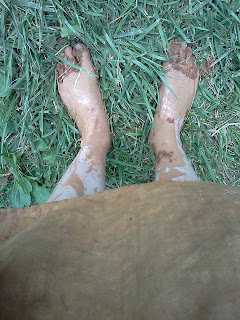We are so close to finishing the little 1740s Settlement cabin! Thanks to the whole slew of new part time folks, we've finally had the staff to complete the project we began four years ago. All we have to do is build up the chimney a few feet higher, and make a front door.
So how do you daub a cabin? Today, many historic homes with modern residents have long since replaced their daub with a concrete mix in between their logs instead of mud. We won't tell you which ones, but some historic sites cheat and do that too, because the walls don't need constant maintenance, and it helps keep a more comfortable temperature inside for visitors or collections on display. Daubing is also a dirty process, and there aren't many folks like ourselves out there willing to live in a mud pit for days on end.
Before you can daub, you need to cut up small slats of wood to place between each log. This is the chinking process. They should be set in on an angle, which you'll see in some of the later pictures. This is a very important step, as the chinking works as a support frame for the mud.
If you want to do a proper historic daubing, you'll need to gather up some materials. First, find a bucket to carry water, and a sturdy pick or shovel. Don't use ones you like a lot, because they will get caked in mud. Make sure you clean off your tools at the end of the day, and be prepared to hide them quickly during the day, in order to prevent your curator from having a heart attack.
Next, find a nice spot to dig a pit, where you can get some good dirt with a high clay content. Straw is useful for binding your mud daub, so put a pile next to your pit.
Get some dirt loose in your pit, throw in some of your water, top off with a handful of straw, take off your socks and shoes, and you are ready to jump in! Just be careful, there may be sharp rocks. You can sift your dirt with a screen if you have a fear of cutting up your feet, or plan to have children/visitors jump in too. Sifted or not, hop in and start mixing that mud!
We are much indebted to the Augusta County Militia, a quality Revolutionary War living history organization, for volunteering and helping us work on this cabin. They generously came and built our chimney last Oktoberfest, and then stayed on an extra day after the 4th of July to start the daubing. They also kindly helped train one of our new part timers, whose first day in costume coincided with their visit.
You can probably start anywhere, but we started with the chimney. We plated the mud on some old broken wooden shingles. It's best to have at least one person working inside and one person working outside opposite the other, because some of the chinking or stones may not be as tight as when you first put them in.
The Augusta County Militia guys chose Will Gore, who also is a volunteer at our museum. Notice below, where he employs the "Smash and Smear" method of daubing.
The ACM got our chimney half finished, but taught our interpretive staff some valuable tricks to getting a lot done in a day. We learned to embrace the mud.
Over the course of the next few weeks, Drew (my co-worker) and I continued the daubing, except for the top part of the chimney. We had some summer campers help us on a couple days, too, and while they happily figured out the "smash" part, we found that we needed to jump in and help with the "smear" part. But Drew and I carried onwards.
We got the entire front face of the house done in a day, the back face done another day, and the reachable portions of the north and south facing walls done too. This left us with the top of the gables, in the high unreachable areas.
Now, if you know anything about period clothing, you'll notice we've all stripped down to our underwear. Your clothes will get caked in mud, and it was common back then in situations of intense labor or dirt for people to take off coats, waistcoats, jackets, etc. And the less that gets dirty, the less laundry you'll have to do in the morning!
Our system worked well for the south face wall, but we had to make some adjustments to get the outside north face daubed because of the chimney. Andy made himself a nice little seat, and got started. The two boys inside continued their system successfully.
The Frontier Culture Museum is a living history farm that believes in hands-on participation. We invite visitors to help us do flax processing, grinding oats, cooking, gardening, woodworking, and all sorts of other activities. Throughout the daubing process, I invited many visitors to jump in and join us! Surprisingly, no one ever took me up on the offer. In fact, most people laughed at us, in our mud-encrusted state. Nobody wanted to embrace the mud.
Nobody, until a young a fearless Jonna Reczek arrived! As usual, I invited some visitors to join us, expecting heart break once more, but alas! Imagine my surprise when one girl threw off her flip flops and hopped in the mud! We even warned her of the danger of rocks underfoot, but she trooped on. She not only embraced the mud, she became one with it. Thank you, Jonna!
We finished daubing the cabin shortly thereafter. Once you finish your cabin, go inside, and take a few minutes just to enjoy the view.



































